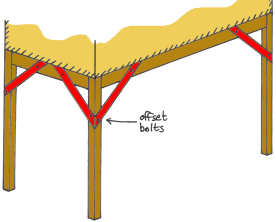Types of support | Flexible supports | Rigid framed supports | Fixtures and fastenings | Metal brackets | Cables
Knee braces | Dangerous things to avoid | Non-flat surfaces | Improving stability | Building without trees
Building a house without trees
In my view, you can only call something a 'treehouse' if it is mainly supported by the tree. Posts can be an indicator that the tree isn't capable of carrying a structure quite so large in it. However, many beautiful houses have been built with careful use of posts to reduce load on sensitive parts of the tree, and this must be commended. It is even possible to disguise posts using concrete that looks amazingly like a real tree holding up part of the structure.
Using posts only
A lot of people have small gardens and would really like their own treehouse, but simply don't have a tree capable of holding one up. The solution comes in the form of a raised platform on posts. The posts are mounted in concrete in the ground and are braced together to reduce any wobble as shown in the diagram on the right. This example has a floor area of 8'x4'.

4x4 posts are a good start and should be combined with bracing, particularly if you start getting higher off the ground (over 5 feet). Round poles of 5" diameter or more are also good—there are no corners to hurt children who may be playing there. In this example, an exterior frame of 2x6 is bolted to the posts, filled in with 2x4 joists. A plywood floor is laid on top, which takes care of any twisting at floor level.
Securing posts in concrete
It is a good idea (though not essential) to secure posts into the ground with concrete, so that they can't sink or work loose. You can either fix the post directly in the concrete, or set a post bracket. A bracket keeps the post off the ground so it will last longer. Treat the ends of each post with creosote or wood preservative to protect them from rot.
Frost
If the ground freezes, it expands slightly as water solidifies. This can push shallow foundations out of position in a process known as 'heave'. You can avoid this problem by keeping the base of the concrete below the frost line (2 feet or more), so you will have to dig an extra foot or more deeper than that. Ask a local builder what the frost line depth is in your area as this varies considerably. The hole for the concrete should be flared outward at the bottom to ensure the concrete has a good grip on the surrounding earth. Wet concrete should not be used in freezing conditions. If a sudden frost is expected, you can cover wet concrete with an old carpet, plywood or other insulating materials to prevent it freezing before it sets.
Holes for the supports must be away from areas where subsidence might occur (eg, near a river that might flood). It is important to avoid damaging the roots of the tree, as you are likely to be close to them with these posts. If you encounter roots thicker than your thumb, move the hole slightly to avoid them. Cut small roots rather than encasing them in concrete. If they continue to grow, they could split the concrete, weakening the support.
Dig a narrow hole where the post should go, preferably with a post hole digger (this looks like two spades connected together in the middle). Set in the post or bracket and fill up to just below ground level with concrete. Using a prepared concrete mix (eg, Quikrete) keeps things simple. You can work out the quantity of concrete you'll need by measuring the volume of the hole, or your hardware store can help to calculate how much you'll need once you know the size of the holes. You can adjust the exact position of the post or bracket after the concrete has just been added. Use lengths of scrap wood to hold the post or bracket stable and perfectly vertical until the concrete has set. Initial set should be within 24 hours, but allow an extra day or two before adding other supports and load to the posts. Cover the set concrete with soil and grass to leave a neat finish.
Using posts as additional support for a treehouse
The posts and holes follow the same principles as above, but now you have a tree or trees involved so the support structure needs to take up movement of the tree without getting damaged. For low treehouses (to about 8'), the natural flexibility of the posts is usually enough to absorb this movement. In these situations, avoid adding too much bracing to the posts as this will reduce their flexibility. Most of the time, the tree will be the most solid point in the system, so bolt one part of the support system to the tree and allow the posts to take up any movement. For larger treehouses supported mostly on posts, use the posts as the solid fixing point and use a flexible joint where the floor meets the tree, and use more extensive bracing to stiffen the structure.
Types of support | Flexible supports | Rigid framed supports | Fixtures and fastenings | Metal brackets | Cables
Knee braces | Dangerous things to avoid | Non-flat surfaces | Improving stability | Building without trees
